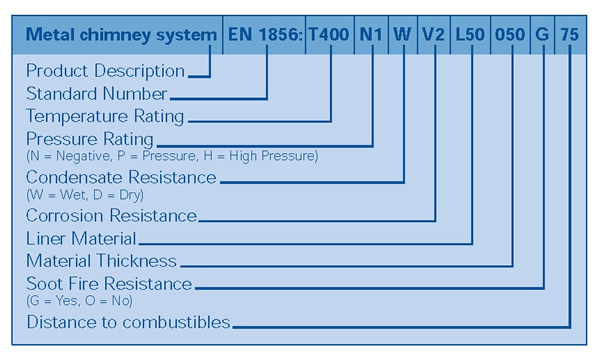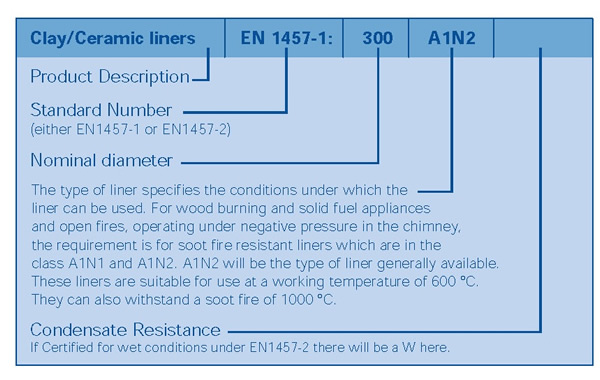CE Designations
One of the key features of the European Standard for metal chimneys (EN 1856) is a user-readable classification system that designates the features of the product. A label showing the classification must go with each flue component. Understanding the classification can make the job of selecting the right flue much easier and will allow you to compare different flues. It’s easy to use so long as you know the keys. The diagram below unlocks the coded information.

Picking out a few of the main points:
Temperature Rating Maximum temperature (°C) for continuous use of the flue. T400 is suitable for multi-fuel. T200 is suitable for gas and oil.
Corrosion Resistance This is fuel dependent as follows;
V1 Resistant to attack from products of combustion from gas.
V2 Resistant to attack from products of combustion from light oil (sulphur content up to 0.2%) and natural wood. If the flue passes the V2 wet test then it is also deemed to comply with D3 & V3 under dry conditions.
D3 Resistant to the products of combustion from burning wood under dry conditions.
V3 Resistant to attack from products of combustion from heavy oil (sulphur content > 0.2%), solid fuels and peat.
VM Not tested but rating declared by the manufacturer.
Liner Material and Thickness 316L, is the highest quality grade and is expected to withstand the corrosion effect of multi-fuel, wood or heavy oil. The code for 316L is L50. Light oil is less corrosive and normally 304 (L20) has proved adequate in dry conditions, but in the increasingly common wet conditions created by high efficiency condensing boilers, the higher grade is required (316L). The thickness is the steel thickness in mm.
Soot Fire Resistance and Distance to Combustibles Expressed as either G, for soot fire resistance or O for not, followed by the declared minimum distance to combustibles expressed in mm. To obtain the G classification means that the product has been tested at 1000°C for 30 minutes and remains intact. The temperature of combustible material at the designated distance must not exceed 100°C at an ambient temperature of 20°C.
Distance to Combustibles for Connecting Flue Pipe Connecting flue pipes to BS EN 1856-2 also have an additional classification M (Measured) or NM (Not Measured). If not measured the minimum distance to combustibles should be 3 times the internal diameter of connecting flue pipe. Connecting flue pipes to BS EN 1856-1 should be used in accordance with the manufacture's declared distance to combustibles.
Flue Testing The flue should be fully tested in an enclosed combustible shaft.
The main change in the new standard for clay/ceramic flue liners, published in January, 2012, is the fact that the standard was split into two sections. BS EN 1457 part 1 is the standard for clay/ceramic flue liners operating under dry or non-condensing conditions. BS EN1457 part 2 covers liners operating under wet/condensing conditions. Under wet conditions condensation will be on the inside of the flue liners typically arising from the operation of modern and more efficient lower exhaust gas temperature appliances. The structure of the label is the same in both parts.

The standard for concrete liners is BS EN 1857:2010 The types of liner are classified in a similar way to clay liners, with the result that the same classes are required for wood burning and solid fuel appliances and open fires. A1N1 and A1N2 concrete liners can only be used under dry conditions.



